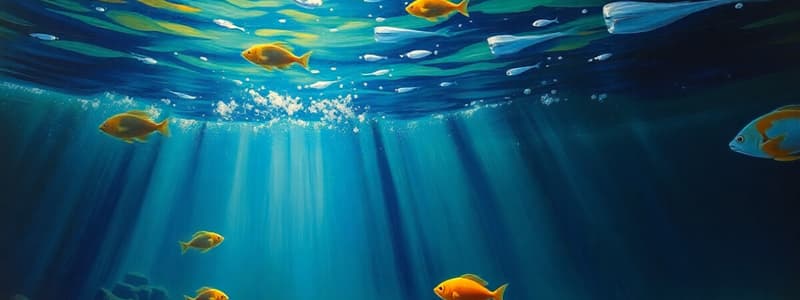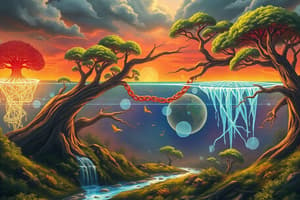Podcast
Questions and Answers
What is the primary reason organisms compete within ecosystems?
What is the primary reason organisms compete within ecosystems?
- For limited resources such as food and water (correct)
- For territorial claims over space
- For reproduction opportunities
- For dominance over other species
Which ecosystem type is the least common on Earth's surface?
Which ecosystem type is the least common on Earth's surface?
- Marine ecosystems
- Desert ecosystems
- Terrestrial ecosystems
- Freshwater ecosystems (correct)
What percentage of photosynthesis on Earth is performed by phytoplankton in marine ecosystems?
What percentage of photosynthesis on Earth is performed by phytoplankton in marine ecosystems?
- 25 percent
- 40 percent (correct)
- 60 percent
- 10 percent
Which of the following is NOT a critical factor influencing community dynamics in ecosystems?
Which of the following is NOT a critical factor influencing community dynamics in ecosystems?
What are the three basic types of marine ecosystems?
What are the three basic types of marine ecosystems?
How do terrestrial ecosystems differ from freshwater and marine ecosystems?
How do terrestrial ecosystems differ from freshwater and marine ecosystems?
Which ecosystem typically supports a wider variety of organisms?
Which ecosystem typically supports a wider variety of organisms?
What role do large numbers of plankton play in marine ecosystems?
What role do large numbers of plankton play in marine ecosystems?
What can cause an ecosystem to lose its resilience?
What can cause an ecosystem to lose its resilience?
Which of the following correctly defines a food chain?
Which of the following correctly defines a food chain?
What is the role of primary consumers in a food chain?
What is the role of primary consumers in a food chain?
Why is energy transfer limited in a food chain?
Why is energy transfer limited in a food chain?
What defines the apex consumer in a food chain?
What defines the apex consumer in a food chain?
Which organism is an example of an apex consumer in the Lake Ontario food chain?
Which organism is an example of an apex consumer in the Lake Ontario food chain?
What typically forms the base of a food chain?
What typically forms the base of a food chain?
What is a trophic level?
What is a trophic level?
What role do chemoautotrophs play in hydrothermal vent ecosystems?
What role do chemoautotrophs play in hydrothermal vent ecosystems?
Why is biomagnification a concern in ecosystems?
Why is biomagnification a concern in ecosystems?
Which of the following substances is mentioned as having biomagnified in ecosystems?
Which of the following substances is mentioned as having biomagnified in ecosystems?
What is a consequence of DDT accumulation in bird populations?
What is a consequence of DDT accumulation in bird populations?
At what depth was the submerged NW Eifuku volcano located, according to the information provided?
At what depth was the submerged NW Eifuku volcano located, according to the information provided?
How do chemoautotrophic bacteria contribute to the hydrothermal vent ecosystem?
How do chemoautotrophic bacteria contribute to the hydrothermal vent ecosystem?
Which of the following statements about polychlorinated biphenyls (PCBs) is accurate?
Which of the following statements about polychlorinated biphenyls (PCBs) is accurate?
What is the main source of energy for organisms living in hydrothermal vent ecosystems?
What is the main source of energy for organisms living in hydrothermal vent ecosystems?
What has been a significant consequence of increased fossil fuel burning since the Industrial Revolution?
What has been a significant consequence of increased fossil fuel burning since the Industrial Revolution?
Which process allows autotrophs to convert carbon dioxide into organic compounds?
Which process allows autotrophs to convert carbon dioxide into organic compounds?
What is the main byproduct of photosynthesis that benefits heterotrophs?
What is the main byproduct of photosynthesis that benefits heterotrophs?
How do terrestrial and marine autotrophs mainly acquire carbon dioxide?
How do terrestrial and marine autotrophs mainly acquire carbon dioxide?
What is a primary role of photosynthetic organisms in the atmosphere?
What is a primary role of photosynthetic organisms in the atmosphere?
Which group of organisms is primarily involved in the exchange of carbon with autotrophs?
Which group of organisms is primarily involved in the exchange of carbon with autotrophs?
Which factor does NOT directly contribute to the carbon cycle's long-term storage of carbon?
Which factor does NOT directly contribute to the carbon cycle's long-term storage of carbon?
What significant chemical change occurs during photosynthesis?
What significant chemical change occurs during photosynthesis?
Which process in the nitrogen cycle directly converts nitrogenous waste into ammonium?
Which process in the nitrogen cycle directly converts nitrogenous waste into ammonium?
What is the final product of the denitrification process?
What is the final product of the denitrification process?
During nitrification, what are nitrates converted from?
During nitrification, what are nitrates converted from?
Which of the following statements about nitrogen-fixing bacteria is true?
Which of the following statements about nitrogen-fixing bacteria is true?
What human activity is associated with the release of nitrogen oxides into the environment?
What human activity is associated with the release of nitrogen oxides into the environment?
Which bacterium is specifically mentioned as playing a role in the denitrification process?
Which bacterium is specifically mentioned as playing a role in the denitrification process?
What environmental issue is associated with atmospheric nitrogen other than nitrogen gas?
What environmental issue is associated with atmospheric nitrogen other than nitrogen gas?
Which of the following processes does NOT play a role in the nitrogen cycle as described?
Which of the following processes does NOT play a role in the nitrogen cycle as described?
What is a major consequence of fertilizer runoff?
What is a major consequence of fertilizer runoff?
Which processes are involved in the marine nitrogen cycle?
Which processes are involved in the marine nitrogen cycle?
How does nitrogen from rock contribute to the nitrogen cycle?
How does nitrogen from rock contribute to the nitrogen cycle?
What role does phosphorus play in biological systems?
What role does phosphorus play in biological systems?
Why is phosphorus often considered a limiting nutrient in freshwater ecosystems?
Why is phosphorus often considered a limiting nutrient in freshwater ecosystems?
What contributes to the natural surface runoff of phosphorus?
What contributes to the natural surface runoff of phosphorus?
From where does phosphorus sediment primarily originate in the ocean?
From where does phosphorus sediment primarily originate in the ocean?
How does phosphorus cycle between marine organisms and the ocean?
How does phosphorus cycle between marine organisms and the ocean?
Flashcards
Ecosystem Categories
Ecosystem Categories
Ecosystems are broadly categorized into freshwater, marine, and terrestrial.
Freshwater Ecosystems
Freshwater Ecosystems
Relatively uncommon, freshwater ecosystems include lakes, rivers, streams, and springs, and are home to a variety of life forms.
Marine Ecosystems
Marine Ecosystems
The most common ecosystem type, comprising 75% of Earth's surface and including shallow ocean, deep ocean water, and deep ocean bottom.
Terrestrial Ecosystems
Terrestrial Ecosystems
Signup and view all the flashcards
Competition in Ecosystems
Competition in Ecosystems
Signup and view all the flashcards
Environmental Influences
Environmental Influences
Signup and view all the flashcards
Biodiverse Ecosystems
Biodiverse Ecosystems
Signup and view all the flashcards
Plankton in Marine Ecosystems
Plankton in Marine Ecosystems
Signup and view all the flashcards
Food Chain
Food Chain
Signup and view all the flashcards
Trophic Level
Trophic Level
Signup and view all the flashcards
Producers
Producers
Signup and view all the flashcards
Primary Consumers
Primary Consumers
Signup and view all the flashcards
Apex Consumer
Apex Consumer
Signup and view all the flashcards
Ecosystem Resilience
Ecosystem Resilience
Signup and view all the flashcards
Food Web
Food Web
Signup and view all the flashcards
Energy Loss in Food Chain
Energy Loss in Food Chain
Signup and view all the flashcards
Chemoautotrophs
Chemoautotrophs
Signup and view all the flashcards
Hydrothermal vents
Hydrothermal vents
Signup and view all the flashcards
Biomagnification
Biomagnification
Signup and view all the flashcards
Persistent toxins
Persistent toxins
Signup and view all the flashcards
DDT
DDT
Signup and view all the flashcards
Fat-soluble toxins
Fat-soluble toxins
Signup and view all the flashcards
Carbon Cycle
Carbon Cycle
Signup and view all the flashcards
Biological Carbon Cycle
Biological Carbon Cycle
Signup and view all the flashcards
Autotrophs
Autotrophs
Signup and view all the flashcards
Heterotrophs
Heterotrophs
Signup and view all the flashcards
Photosynthesis
Photosynthesis
Signup and view all the flashcards
Respiration
Respiration
Signup and view all the flashcards
Fossil Fuels
Fossil Fuels
Signup and view all the flashcards
Climate Change
Climate Change
Signup and view all the flashcards
Nitrogen Fixation
Nitrogen Fixation
Signup and view all the flashcards
Ammonification
Ammonification
Signup and view all the flashcards
Nitrification
Nitrification
Signup and view all the flashcards
Denitrification
Denitrification
Signup and view all the flashcards
Human impact on Nitrogen Cycle
Human impact on Nitrogen Cycle
Signup and view all the flashcards
Consequences of excess nitrogen
Consequences of excess nitrogen
Signup and view all the flashcards
Primary Production
Primary Production
Signup and view all the flashcards
Decomposition
Decomposition
Signup and view all the flashcards
Eutrophication
Eutrophication
Signup and view all the flashcards
Limiting Nutrient
Limiting Nutrient
Signup and view all the flashcards
What is the role of phosphorus in the ocean?
What is the role of phosphorus in the ocean?
Signup and view all the flashcards
Phosphate Ion
Phosphate Ion
Signup and view all the flashcards
Nitrogen Cycle in the Ocean
Nitrogen Cycle in the Ocean
Signup and view all the flashcards
What is the significance of phosphorus in aquatic ecosystems?
What is the significance of phosphorus in aquatic ecosystems?
Signup and view all the flashcards
Reciprocal Exchange
Reciprocal Exchange
Signup and view all the flashcards
Study Notes
Ecosystems and the Biosphere
- Ecosystem ecology extends organismal, population, and community ecology
- Ecosystems encompass all biotic (living) and abiotic (non-living) components in a geographic area
- These abiotic components include air, water, soil, and climate
- Ecosystem biologists study nutrient and energy flow between organisms and the surroundings
- Example habitats include oak-pine barrens in regions like Indiana, Michigan, and Wisconsin
- These habitats are characterized by natural disturbances, like fire, and low soil nutrients, like nitrogen
Energy Flow through Ecosystems
- Ecosystems are categorized as freshwater, marine, and terrestrial, with various types within each
- Life in ecosystems involves competition for limited resources like food, water, sunlight, space, and minerals
- Physical factors like climate, elevation, and geology strongly influence ecosystem dynamics and community composition
- Some ecosystems are quite diverse, like the Amazon rainforest
- Others are smaller and more specific, like tidal pools
Biogeochemical Cycles
- Energy flows directionally through ecosystems, entering as sunlight or inorganic molecules
- Matter is conserved and recycled, not flowing like energy
- The six most common elements in organic molecules (carbon, nitrogen, hydrogen, oxygen, phosphorus, and sulfur): cycle continuously within ecosystems
- Geologic processes like weathering and erosion play a crucial role in cycling
- Biogeochemical cycles connect biotic and abiotic environments
- Water, carbon, nitrogen, phosphorus, and sulfur are key elements in these cycles
Studying That Suits You
Use AI to generate personalized quizzes and flashcards to suit your learning preferences.




